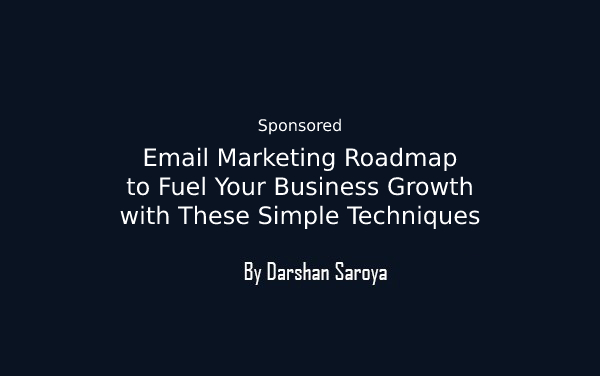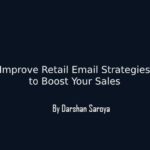There are many avenues available for your marketing strategy with social media, Google, and direct platform advertising, but none of these can fuel your business growth quite like email marketing.
While email is a long-term strategy, it’s one you can leverage again and again, at no cost to you. Here is a helpful roadmap of strategies and best practices to get you started on the right track.
Table of Contents
Why Email Marketing is the Best Avenue to Growth
Email is the king of marketing, and will likely remain so. Even with all the newfangled apps, platforms, and shiny social media tools, nothing beats direct access to your customer’s digital home base.
Highest Return on Investment
If your messaging is zeroed in and you’re reaching the right customers, any good marketing campaign should get you a return on your investment. However, email marketing offers an ROI average of 4400%. That’s a 4.4 thousand percent return!
Customers who engage with email offers are likely to spend 138% more than leads from other sources. There’s a certain level of trust you have achieved when you’ve made to the inbox that inspires action.
Access
Email is platform-free! Inside a customer’s email inbox, there are no algorithms and no platform politics. Meaning you have unfiltered access directly to the customer.
This also means you need the recipient’s permission to send them sales and marketing emails, This issue is easily resolved with any opt-in or registration strategy.
Your Email List is Yours, You Own It
You may have thousands or tens of thousands of followers on Instagram. Or you may have hundreds of members in your Facebook Community. Maybe you have views on YouTube in the hundreds of thousands.
The reality is, you don’t own a single one. YouTube, Facebook, Instagram, and every other platform out there can take them all away with one strategic change to the algorithm or updated user policies.
Or heaven forbid, your primary platform goes down due to a technical difficulty! Then where will you be? Dead in the water.
But, once you build and grow an email list, it’s YOURS. You have asked for and earned those contacts and you can engage with and sell to them whenever you want.
The Roadmap to Fuel Business Growth with Email Marketing
Effective email marketing requires a strategy, a plan, especially if you don’t have an existing list to market to. Your roadmap starts here!
Grow Your Email List
You could write the best, most conversion-worthy emails anyone has ever seen, but if you don’t have a list to send them to, you’ve put the cart before the horse.
The most straightforward way to grow your email list is to offer a lead magnet. This is a helpful resource or desirable offer that your prospects want, usually free, that they can have for the cost of their email address.
If you have a decent social media following, a content post with the link to your resource may get you going. But if you’re starting from scratch, try creating an ad campaign on your preferred platform.
Send anyone who clicks to a landing page with an enticing headline and a clear description of what is being offered. Remind them why they clicked in the first place by keeping your messaging consistent.
Keep the form simple asking only for the basics like name and email so you don’t scare them off. Any graphics should be clear and aesthetically pleasing, tying in with your branding.
The call to action or subscribe button should inspire them to take action. “YES, get me this result!” or “Send me this great resource!” or “YES! I want the thing you have!” Try to keep reminding them why they clicked and what they really want.
Lead magnet suggestions:
- Checklist or cheat sheet relevant to their needs
- An ebook that showcases your expertise
- A quiz to reveal something they’re curious about
- Access to a free but incredibly valuable webinar
- Free trial subscription or sample
- A case study or whitepaper on a relevant topic
- A free consultation
- Exclusive discount
A lead magnet should be something that’s easily digestible. You must find a balance between providing value and actually helping the lead achieve something while also leaving them wanting more.
Do your client research, learn what it is they are looking for and what kind of resource would actually make a difference for them. Solve a problem with your lead magnet, this is NOT exclusively a sales opportunity. Create a few and test which one has the highest conversion rates.
Your resource should also be delivered immediately, either via email or load in their browser after they’ve provided an email. Don’t make them wait a week for your webinar or the chances of them actually attending will drop significantly.
Get Organized!
Before you start getting emails, set up Customer Relationship Management (CRM) software. This will help you organize all of your contacts, be able to categorize where each lead came from, and keep all of your leads in one place.
A CRM will also help you automate and schedule certain functions so you can “fix it and forget it.” Depending on the software you choose, you may be able to trigger a future action based on how the lead came in or what list they’re attached to.
Most CRMs offer a free membership or trial. Some of the most popular are:
- MailChimp
- HubSpot
- Active Campaign
- Mailerlite
- ConvertKit
- GoHighLevel
- Drip
Test a few out and see what fits your needs the best.
Segmenting
With a CRM comes the ability to segment your audiences. If you created several different lead magnets about different topics, you can categorize what emails that lead should receive, based on the magnet they responded to.
For example, if your lead magnet was an ebook on how a new driver can pass their permit test, follow-up emails should be related to that goal. If they responded to a quiz about which social media platform is best for their content, follow-up emails should be in the same family of information.
Segmenting allows you to separate new leads from existing ones and only send information relevant to where they are on their customer journey. Once a new lead has received initial follow-up emails or a welcome sequence, they should be sufficiently warmed up to who you are, what you do, and how you can help them.
Suggested categories for email list segmentation:
- New leads
- Subscribers only interested in a specific topic
- Geographic location for local offers
- Leads who indicated they do not want offers
- Contacts with high open rates
- Shoppers who abandoned their cart without making a purchase
Plan to Succeed
If you start sending out emails, with no clear direction, the results will be random at best. Your ROI is more likely to be unsuccessful and disappointing.
You must have a clear goal for your email marketing campaign. What are you trying to achieve?
Do you want to engage existing email contacts? Warm-up new subscribers? Increase sales? Boost traffic to your website?
All of these goals will influence how you set up your email campaign and what you say along the way. Map out your entire email marketing plan from the time a viewer clicks on your ad or your content to the step where they receive their first welcome email.
Make sure messaging and branding are consistent and that your call to action isn’t confusing.
Once you have them in your circle, continue to create content that will inspire readers to take the desired action. Remind them why they’re in your world.
Create Email Sequences in Advance
Maybe you’re thinking, “there’s no way I have time to send out all these emails all the time!”
And you’re probably right! If you send out these emails, one at a time, when needed, you’d suck valuable time out of your day and probably pull your hair out.
Block out a few hours every few weeks and batch email creation together. If you’re sending follow-up emails related to a new lead magnet, draft three to seven emails that all relate to that original topic.
This is where that segmenting pays off! If you have a list dedicated to helping students understand traffic safety and road signs, you don’t want to also send them emails created for driver’s ed teachers. While the topic is related, the intent and perspective are drastically different and so should the emails be.
It’s important that you don’t just sell in every email. You should be offering valuable insights, content, resources, and education at a ratio of 80:20. 80% should be value-driven content and only 20% should be related to selling.
You can create a sequence about anything! Write for new leads, seasonal content, new product announcements, new resources, a refresh on old resources, your industry insights, customer success stories, or one larger sequence with elements of all these topics.
Don’t worry, if you’re not a DIY writer, there are plenty of agencies out there who are trained to pump this type of content out by the hour. You don’t have to do something you hate — that’s not why you started your business!
Email Marketing Tips for success
To bring it all home, here are a few tips to help your email marketing campaign be as successful as possible!
Keep Your Tone Conversational
There’s no need to bury your reader in a mountain of industry jargon. They don’t want to read it and you’ll probably see an uptick in unsubscribes.
Remember, you’re speaking to an actual live person! Write like it. Use humor, cultural references, and even gifs or emojis depending on your audience.
Don’t Drone On
The modern-day attention span is short and flighty. Most readers don’t stick around for emails longer than three to five hundred words. If your content is longer, make it a blog post instead and hype it up in your email, sending the reader to your website.
Spam Triggers: Don’t Do These
You want to avoid the spam filter at all costs! The chances of being read or even seen are slim to none. Don’t create a killer, baiting subject line that has nothing to do with what’s in the email.
Avoid messy or complicated email templates, keep it simple and easy on the eyes. Use your contact’s name in the subject line to make it more personal.
Keep away from all the slimy sales words like “buy”, “clearance”, “discount”, and “cash”. Show recipients how to “whitelist” you or add to the address book.
Formatting
A huge block of text is an almost immediate email killer. Break up your emails into several paragraphs containing a maximum of two to three sentences each. Use bullet points and the occasional bold text to make important points stand out.
Take Your Roadmap and Grow!
Start your research today and plan how you’re going to fuel your business growth through email marketing. The sooner you get started, the sooner you will benefit from the results!
Author: Tim Waldenback
Tim Waldenback is the co-founder of Zutobi, a gamified e-learning platform focused on online drivers education to help teens get their license. Tim founded Zutobi to make world-class driver’s education fun, affordable, and easily accessible for all.







Leave Your Comment Here